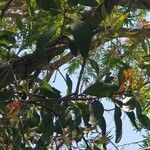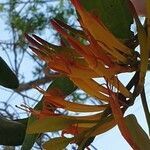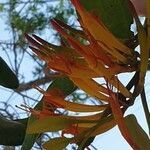Plant spreading to pendulous, glabrous or inflorescence axes and ovary with sparse white indumentum; epicortical runners usually present. Leaves displaced-opposite or alternate, lanceolate to elliptic (rarely almost orbicular), rounded at apex; lamina 3–20 cm long, 1–6 cm wide, attenuate at base into petiole 3–25 mm long, isobilateral, leathery; venation distinct or obscure except prominent midrib. Inflorescence axis 10-30 mm long, with 5–20 flowers; pedicels 3–5 mm long; bracts 1.5–2 mm long, acute. Calyx entire or weakly toothed, sometimes irregularly split, 1–2 mm long. Corolla in mature bud 2–5 cm long, yellow to light red. Anthers 3–5 mm long, about equal to free part of filament. Fruit ovoid, 10–15 mm long, yellow to red.
A plant which grows attached to other plants. It is spreading and hangs down. The leaves are leathery and without hairs. The leaves are 3-20 cm long. The flowers occur in clusters of 4-8. There can be up to 20 flowers in a cluster. The flowers are yellow to orange and 2-5 cm long. They are inflated in the middle and curved and split on the inward curving side. There are 5 petals joined to above the midpoint. The fruit is yellow to pink and a berry. It is 1-1.5 cm long.



